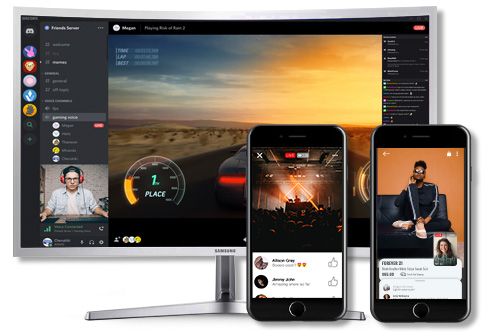The Future of Streaming: 2020 and Beyond

Download our report, The Future of Streaming: 2020 and Beyond, or explore our interactive table of contents below.
Introduction
Growing up in the 90s, I imagined a future where video chats replaced phone calls and live holograms headlined concerts. While this future was largely inspired by Disney’s Zenon: Girl of the 21st Century, my imagination took a surprisingly conservative stance on the prominence of video streaming in 2020 and beyond.
Netflix is now a verb, and FaceTime is a means of communication. Doggy daycares broadcast pet content to websites, while doorbell cams stream surveillance video to homeowners’ mobile devices. Drones, GoPros, and medical devices all have streaming technology built in.
Just look at the FAANGs (the five top-performing U.S. tech stocks: Facebook, Amazon, Apple, Netflix, and Google). All of them are in the streaming game. Facebook brought us Facebook Live, Amazon has Amazon Prime Video, Apple recently launched Apple TV+, Netflix is Netflix, and Google owns YouTube. Beyond broadcasting though, the FAANGs are using streaming to power smart home technology, video-enabled wearables, and more.
This is where we begin to discover the most exciting use cases. Rather than merely selling streaming as a service, today’s most innovative companies are integrating live video into their products to create entirely new offerings — thus pushing the limits of what can be achieved.
This report details the biggest trends in live streaming, next-generation applications that will go mainstream, critical technologies paving the way, and our predictions for the decade ahead.
Table of Contents
Big Trends
Within the first few months of 2020, we’ve already seen a rapid increase in the role video streaming plays in everyday life. The COVID-19 outbreak has demonstrated how essential virtual learning, video conferencing, telemedicine, and similar technologies are to business continuity. Below, we look at the trends that will continue to guide our increasingly virtual world.
1. Limitless Streaming Applications
While the so-called streaming wars have captured much of the media’s attention, broadcasting only accounts for one subset of the digital video landscape.
Solving for a global pandemic? Streaming could play an essential role in stopping the spread. Building a smart city? We’d suggest incorporating video-enabled infrastructure. Looking for a tool to digitally transform your business? Take a page from Netflix’s book (circa 2007) and expand your offering with streaming technology.
For problems big and small — with applications nuanced and broad — streaming delivers the flexibility required for wide-ranging adoption. What’s more, the technology has become increasingly accessible in recent years. Gone are the days when organizations needed an in-house engineering team to implement video streaming.
The proliferation of video across so many applications can be attributed to ever-expanding connectivity, improved quality, and sophisticated technology. While the engineering behind it remains complex, new tools are helping to democratize live streaming implementation. What’s more, a focus on customer success is driving vendors to offer training and consulting services — which we’ll elaborate on in trend number three.

2. Intelligent Data Automation
The prevalence of technology in our lives is fueled by data. And as the commodity that keeps on giving, data is more abundant than ever before. But successfully wielding the power of data requires finding innovative ways to acquire, analyze, and act upon it.
Streaming now makes up a considerable chunk of this raw information floating around, with video forecast to account for 82 percent of all internet traffic by 2022.
Data automation promises to improve video quality, enhance personalization and targeting, streamline distribution, and revolutionize content indexing. That’s because each time we interact with digital interfaces, more data is created about our consumption patterns. Artificial intelligence and machine learning will drive these improvements, pushing systems past repetitive automation and toward dynamic intelligence.
No matter the goal, a data-first strategy will differentiate the industry leaders from the rest of the pack in 2020 and beyond.
3. Customer-Driven Approach
Today, customer experience is as important as (if not more important than) an organization’s core offering. As a result, smart businesses have moved beyond their focus on tech to a focus on how tech can better serve their customers.
Are your OTT viewers frustrated by watching the same commercial over and over? Use customer intelligence to prevent that from happening. Are your end users looking for a more intuitive user interface (UI)? Engineer an alternative that delivers on these demands.
Customer success is the engine for developing innovative offerings with holistic support. Even Apple, Amazon, and Google recently founded an alliance to ensure compatibility across their smart home devices. Competitors or not, they realized that the customer is always right — and delivering a streamlined experience will ensure mutual success.
Beyond B2C applications, this trend is driving decision-making in the B2B arena as well. Because so many organizations lack video engineering expertise, a number of streaming vendors are evolving to offer professional services that range from product integrations to custom application development.
Whether through partnerships, product innovation, or professional services offerings, we expect this focus on the customer to boost cross-industry collaboration and drive interoperability.
Next-Generation Applications
By integrating streaming technology into every application possible, a number of industries are digitally transforming at an unprecedented rate.
Smart Cities and Surveillance

Smart city spending will reach $189 billion by 2023.1
Healthcare and Internet of Medical Things (IoMT)

An estimated 20-30 billion IoMT devices are in use today.2
Live Commerce and Retail

In China, live stream shopping is a $600 billion market.3
Wearables Devices and Interactive Fitness

The global wearable devices market is expected to reach $62.82 billion by 2025.4
Critical Technologies
While social distancing efforts spurred by the coronavirus outbreak have already catapulted us into a decidedly more digital world, the following three technologies — 5G connectivity, edge computing, and low-latency video delivery — will ensure that video streaming is here to stay.
1. 5G
5G — the fifth generation of mobile communications — will increase bandwidth, resulting in faster speeds and improved energy consumption. This should kill two birds with one stone for video streaming, as quality and latency remain the biggest hurdles in the industry.
5G is expected to transmit information in 1 millisecond or less, thereby enabling digital objects to surpass humans in reaction time. Applications that were once no more than science fiction — such as remote surgical operations and self-driving cars — will become commonplace once 5G takes over.
While the buzzword has been getting a lot of hype, adoption is taking time. That’s because 5G infrastructure and compatible devices are both required to unleash its power. Cisco predicts that 1.4 billion mobile devices will be 5G-capable by 2023, so we’re undoubtedly on our way.
The integration of myriad 5G-enabled devices will automate tasks like never before. For instance, self-driving cars will be able to communicate with other vehicles, traffics lights, sensors, and drones to prevent the accidents we experience all too often when left to our own devices.
2. Edge Computing
The power of edge computing comes down to proximity. For live streaming, this delivers greater scalability and lightning-fast delivery — not to mention advanced artificial intelligence (AI) and machine learning (ML) capabilities.

In a nutshell, edge computing involves decentralizing data storage and computation. Gartner defines it as “a part of a distributed computing topology in which information processing is located close to the edge — where things and people produce or consume that information.”
By bringing real-time processing and decision-making closer to the user, edge computing helps reduce latency, enable advanced analytics, and improve security (among other capabilities).
Edge environments promise to also amplify automation by reducing the volume of data moving through networks. This will become increasingly important as 5G is rolled out, and the internet of things (IoT) takes over.
3. Low-Latency Protocols
Over the past ten years, the streaming industry has been hard at work driving down latency. Several cutting-edge protocols will serve as the tools to deliver low-latency streaming at scale. These include Web Real-Time Communications (WebRTC), Secure Reliable Transport (SRT), the Common Media Application Format (CMAF), and Apple’s Low-Latency HTTP Live Streaming (LL-HLS) extension.
All of these protocols are available today, and wide-scale adoption promises to follow. In the years ahead, companies will put them to the test for a variety of use cases.
| Protocols | Benefits | Limitations |
| WebRTC | Real-time interactivity without a plugin. | Broadcast quality? Forget about it. Scalability? Only with help. |
| SRT | Smooth playback with minimal lag. | Playback capabilities are still being developed. |
| Low-Latency CMAF | Streamlined workflows and decreased latency. | Still gaining momentum across the industry. |
| Low-Latency HLS | An Apple-supported HLS extension promising sub-two-second latency. | The spec continues to evolve as vendors add support. |
Streaming Predictions
Our three predictions for the future of streaming center around improved interoperability, increased speed, and ubiquitous streaming.
- Improved Interoperability: In many ways, the death of Flash heralds in a new era of enhanced interoperability. The media player’s downfall was brought about in part by Steve Jobs’ criticisms of its proprietary nature. And while proprietary technologies like Apple’s HLS protocol remain prominent in streaming media, open-source alternatives are trending. What’s more, industry leaders are partnering to provide more holistic solutions for their customers. CMAF represents an attempt made by Apple and the Moving Pictures Expert Group to eliminate complexity, whereas the AV1 video codec came about via an alliance formed by Amazon, Netflix, Microsoft, Cisco, and Mozilla.
- Increased Speed: What do you get when you combine 5G, edge computing, and low-latency protocols? Lickety-split video delivery. Low-latency streaming has always been a goal, but that’s not all. Without also delivering on consumer demands for high-quality video and distributor requirements for scalability, low-latency streaming doesn’t hold a lot of weight. The stage is now set for live streaming to deliver on all three capabilities in the coming years.
- Ubiquitous Streaming: According to Cisco, the number of internet-connected devices will be more than three times the global population by 2023. It’s safe to assume that a number of these will implement live streaming technology — being as today’s smartphones, refrigerators, drones, and cars already do. To put it another way, the internet of things will give way to an internet of streams.

Conclusion
For whatever you’re trying to build, Wowza delivers the technology and expertise required to shape the future of streaming. Our promise is simple: If you can dream it, Wowza can stream it.
Contact us today to learn more.




